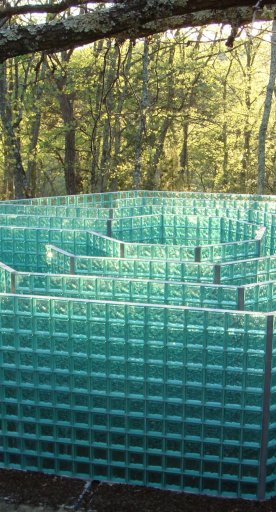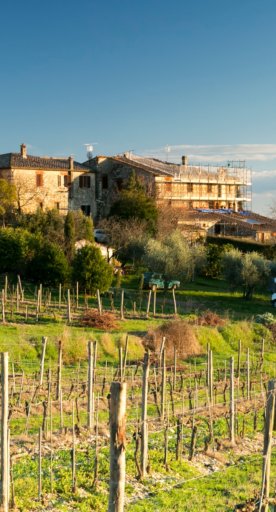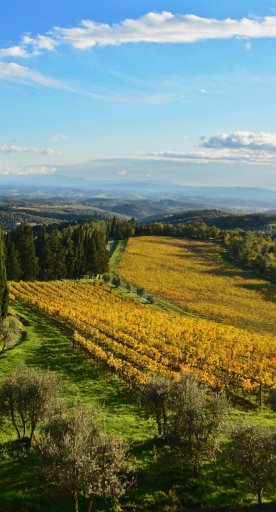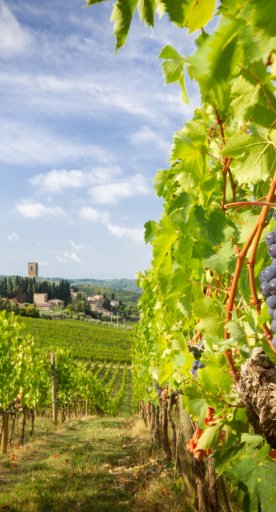Castelnuovo Berardenga
Charming hills, Romanesque churches and a sea of castles in the Chianti area
Nestled among the blossoming Chianti hills and the incredible landscape of the Crete Senesi, the charming area of Castelnuovo Berardenga is found just outside Siena, on the hills separating the first part of the Ombrone valley from the Arbia stream.
A historic settlement area, the Berardenga owes its name to the nobleman of Berardo Frankish lineage, who were alive in the second half of the 10th century and descended from the very Guinigi da Lucca who, from 867 to 881, had been Count of Siena. From the second half of the 12th century, Siena began to exercise even tighter control over Berardenga. A century later, most of the region’s castles had been taken under Sienese control.
What to see in Castelnuovo Berardenga
Castelnuovo Berardenga is a castle settlement with a long history of conflicts and enemy raids, at the centre of disputes due to its strategic position.
Following the battle of Montaperti, which saw the Florentine army defeated by the Sienese in 1260, the Sienese Republic decided to strengthen its outpost by surrounding the highest part of the hill with walls. To distinguish it from the oldest castles in the area, it was called "nuovo" (new), hence the name Castelnuovo. Further fortification works were carried out in 1526 with the construction of seven towers. One such tower is the current civic tower, the only one spared from the demolition of walls and towers at the end of the 18th century and on which a clock was placed.
The demolition of walls gave way to the impressive and elegant complex of Villa Chigi Saracini, with its Italian garden and 19th century park which holds considerable botanical importance.
An entirely unique museum is found in Castelnuovo Berardenga: the Landscape Museum. Located inside a late 19th century building which was once used as a public slaughterhouse. The museum aims to make you reflect on the world’s transformation, the changing of “landscape” and, more generally, the relationship between man and nature.
Castelnuovo Berardenga is a castle settlement with a long history of conflicts and enemy raids, at the centre of disputes due to its strategic position.
Following the battle of Montaperti, which saw the Florentine army defeated by the Sienese in 1260, the Sienese Republic decided to strengthen its outpost by surrounding the highest part of the hill with walls. To distinguish it from the oldest castles in the area, it was called "nuovo" (new), hence the name Castelnuovo. Further fortification works were carried out in 1526 with the construction of seven towers. One such tower is the current civic tower, the only one spared from the demolition of walls and towers at the end of the 18th century and on which a clock was placed.
The demolition of walls gave way to the impressive and elegant complex of Villa Chigi Saracini, with its Italian garden and 19th century park which holds considerable botanical importance.
An entirely unique museum is found in Castelnuovo Berardenga: the Landscape Museum. Located inside a late 19th century building which was once used as a public slaughterhouse. The museum aims to make you reflect on the world’s transformation, the changing of “landscape” and, more generally, the relationship between man and nature.
Nearby
Castelnuovo Berardenga is officially part of the Chianti wine area, being included in the Sienese Hills area as well as that of the Classico, a countryside dotted with castles, fortified villages, stately villas and religious buildings.
One of Castelnuovo’s most interesting medieval history facts is the abundance of castles, including the Montalto Castle in Chianti, owned by the Berardenghi since the 9th century and stratigcally vital thanks to its position on the border between Siena and Florence.
Alongside these, the high number of Romanesque parish churches – like the Church of San Pietro in Cerreto, the Certosa di Pontignano or the Monastery of San Salvatore in Montebona – scattered around Castelnuovo stand as reminders of the great economic and demographic development in the 12th and 13th centuries.
Among the numerous historical villages, we strongly recommend visiting San Gusmè, Geggiano and Pontignano.
The first is surrounded by almost entirely intact walls, inside which is the church dedicated to Santi Cosma and Damiano and the church of Compagnia.
Geggiano owes its notoriety to its famous residence, the Villa Bianchi Bandinelli, dating back to the 14th century and restored in 1700. Together with its Italian garden, the villa is recognised as a national monument.
Pontignano is instead known for its impressive Certosa, where galleries and cloisters lead to small cells and courtyards.
An octagonally-designed chapel traditionally marks Sant’Ansano’s (the first patron of Siena) place of martyrdom; the nearby Church of Sant’Ansano used to hold his body, which has now been transferred to the Cathedral of Siena.
Finally, the original Chianti Sculpture Park is also found near Castelnuovo Berardegna in Pievasciata. The exhibition permanently displays contemporary art installations and sculptures in a setting of an oak and holm oak wood.
Castelnuovo Berardenga is officially part of the Chianti wine area, being included in the Sienese Hills area as well as that of the Classico, a countryside dotted with castles, fortified villages, stately villas and religious buildings.
One of Castelnuovo’s most interesting medieval history facts is the abundance of castles, including the Montalto Castle in Chianti, owned by the Berardenghi since the 9th century and stratigcally vital thanks to its position on the border between Siena and Florence.
Alongside these, the high number of Romanesque parish churches – like the Church of San Pietro in Cerreto, the Certosa di Pontignano or the Monastery of San Salvatore in Montebona – scattered around Castelnuovo stand as reminders of the great economic and demographic development in the 12th and 13th centuries.
Among the numerous historical villages, we strongly recommend visiting San Gusmè, Geggiano and Pontignano.
The first is surrounded by almost entirely intact walls, inside which is the church dedicated to Santi Cosma and Damiano and the church of Compagnia.
Geggiano owes its notoriety to its famous residence, the Villa Bianchi Bandinelli, dating back to the 14th century and restored in 1700. Together with its Italian garden, the villa is recognised as a national monument.
Pontignano is instead known for its impressive Certosa, where galleries and cloisters lead to small cells and courtyards.
An octagonally-designed chapel traditionally marks Sant’Ansano’s (the first patron of Siena) place of martyrdom; the nearby Church of Sant’Ansano used to hold his body, which has now been transferred to the Cathedral of Siena.
Finally, the original Chianti Sculpture Park is also found near Castelnuovo Berardegna in Pievasciata. The exhibition permanently displays contemporary art installations and sculptures in a setting of an oak and holm oak wood.
Events
The festival of Luca Cava in San Gusmè is undoubtedly one of the most original, ironic and well-known in the area. The festival is organised every year in honor of a bizarre local figure, to whom a truly “picturesque” sculpture is dedicated. The statue, made in terracotta following the design of Emilio Giannelli, portrays a man in the position of bodily necessity. The festival takes place every September with a program full of initiatives and spectacles.
The festival of Luca Cava in San Gusmè is undoubtedly one of the most original, ironic and well-known in the area. The festival is organised every year in honor of a bizarre local figure, to whom a truly “picturesque” sculpture is dedicated. The statue, made in terracotta following the design of Emilio Giannelli, portrays a man in the position of bodily necessity. The festival takes place every September with a program full of initiatives and spectacles.
Typical products
Part of Castelnuovo Berardenga falls within the Chianti Classico DOCG area - reserved for wines from the oldest parts of the vast Chianti wine production area – as well as within the production area of Chianti Classico DOP extra virgin olive oil, whose historic tradition has been handed down from generation to generation.
Castelnuovo is located along the Chianti Classico Wine and Olive Oil Trail, which winds between nine municipalities between the provinces of Florence and Siena. Along the trail, you’ll have the opportunity to visit numerous wineries and olive groves, restaurants, craft shops and farmhouses.
Part of Castelnuovo Berardenga falls within the Chianti Classico DOCG area - reserved for wines from the oldest parts of the vast Chianti wine production area – as well as within the production area of Chianti Classico DOP extra virgin olive oil, whose historic tradition has been handed down from generation to generation.
Castelnuovo is located along the Chianti Classico Wine and Olive Oil Trail, which winds between nine municipalities between the provinces of Florence and Siena. Along the trail, you’ll have the opportunity to visit numerous wineries and olive groves, restaurants, craft shops and farmhouses.
What’s nearby?
Chianti


































